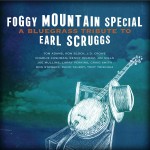
 Much has been written about Earl Scruggs over the years, and most recently since the passing of this icon in American music. With the long-awaited June 5 release of Foggy Mountain Special – A Tribute To Earl Scruggs on Rounder Records, I decided to call up my old friend and colleague, Tim Austin, to congratulate him for Rounder’s decision to release this project he had produced.
Much has been written about Earl Scruggs over the years, and most recently since the passing of this icon in American music. With the long-awaited June 5 release of Foggy Mountain Special – A Tribute To Earl Scruggs on Rounder Records, I decided to call up my old friend and colleague, Tim Austin, to congratulate him for Rounder’s decision to release this project he had produced.
While we were talking I realized the deep respect and admiration that Tim and the rest of the musicians on the project had for Earl. It was clear by the way he referred to Scruggs as Mr. Earl, or Mr. Scruggs in every allusion to the Banjo Master.
Though known primarily as the former guitarist with Lonesome River Band, Tim is also a fine banjo picker. I asked him to describe his own experiences and history with the music of Earl Scruggs, starting with when he first heard Scruggs’ music. After a short pause, Austin reflected…
“My grandfather gave me two Flatt & Scruggs albums when I was about 9 years old, one of which was Live at Carnegie Hall. This got me totally into bluegrass, especially Mr. Earl Scruggs.”
I followed by asking how the love for his work grew? I believe if you can hear a smile over the phone, I heard one as Tim said,
“I picked up the banjo when I was 12 years old. I bought the Earl Scruggs Banjo book and the cassette. I began my journey as all banjo players do, trying to pick like Mr. Earl.”
 As the producer of many bluegrass records for many bluegrass record labels over the past 35 or 40 years including projects for his own Doobie Shea Label, I knew that Tim had done the Scruggs Tribute, but I had forgotten as most of it had been wrapped up in 2008, after getting started in 2006. Knowing Tim as I do, I felt he had been the right man for the job, so to speak, because he puts his heart and soul into all that he does. After all, he has produced several award-winning records as well as the Grammy nominated Stanley Tradition that featured 19 bluegrass artists.
As the producer of many bluegrass records for many bluegrass record labels over the past 35 or 40 years including projects for his own Doobie Shea Label, I knew that Tim had done the Scruggs Tribute, but I had forgotten as most of it had been wrapped up in 2008, after getting started in 2006. Knowing Tim as I do, I felt he had been the right man for the job, so to speak, because he puts his heart and soul into all that he does. After all, he has produced several award-winning records as well as the Grammy nominated Stanley Tradition that featured 19 bluegrass artists.
I went on to ask Tim to describe in his own words what he felt Earl’s contributions were to bluegrass music, as well as other forms of music. He didn’t hesitate to say:
“With Mr. Earl practically owning the 3 finger roll, he created a sound no one else had. How many folks can say that? Because of that, when you hear a banjo playing, you’ve got to think that Mr. Earl invented that.
With that said, there is a lot of banjo in popular music today. As far as bluegrass goes, I believe Earl Scruggs, Lester Flatt and Bill Monroe created Bluegrass music.”
I then asked, for listeners who may only be discovering the music of Earl Scruggs (sadly, now that he has passed), which recordings would you suggest newbie’s to begin with? I am hearing a smile again…
“Well, if they aspire to play the banjo, his instrumental album (Foggy Mountain Banjo) is pretty much the Banjo Bible. I would also start with all the live WSM recordings to hear the fire in his picking. They all are a testimony of how the banjo is played.”
Knowing that the Tribute album had been cut before Earl’s passing, I turned my attention to the project itself and asked how and when did you get the idea for putting together such a project?
“Well, I did a tribute to the Stanley Brothers. That album was nominated for a Grammy. After that I had in my mind to do a bluegrass history kind of record. After trying to compile that, many of their songs basically were Mr. Earl recordings that kept coming up, so I decided I needed to show my respect to him.
In 2006 I approached two labels about doing this project. Ken Irwin at Rounder was the most interested and we made a deal to do it.
I picked out about 20 songs that I wanted to do. Then after talking with Ken and presenting him my list, we decided on the 12 banjo pickers to contact.”
Another thing that brought all of this together was Austin’s friendships with hundreds of A-List musicians that have the same respect and love for Scruggs as his own. I asked him to talk about how he selected the banjo players and accompanying musicians for the sessions.
“I picked out my favorite banjo pickers who have spent their lives wanting to pick like Mr. Earl. Most of these folks are as close as you are going to get to the real thing. These folks are all my friends, some closer than others, but we all have a mutual love and respect for Mr. Scruggs.”
Ultimately, the banjo players chosen were Tom Adams, Ron Block, J.D. Crowe, Charlie Cushman, Kenny Ingram, Jim Mills, Joe Mullins, Larry Perkins, Craig Smith, Ron Stewart, David Talbot and Tony Trischka.
I can only imagine the history of these musicians in the room during these sessions, so I asked Tim to describe the atmosphere between the players in the studio, and what was most memorable when reflecting on the mood, emotional weight, and respectful (even celebratory) performances of the Scruggs material.
“I believe the first song was with Joe Mullins. Wow, did he come to pick or what! He not only came to pick, but his admiration for Mr. Scruggs set the tone of the first session.
I also think that when J.D. Crowe came in, this was a dream come true for me. I have always wanted to record him. We cut that song [Nashville Skyline Rag] about 12 times. I think the band all wanted to play with J.D.”
Not only was picking the banjo players for the album given great thought and consideration, it may have been even harder to select the musicians that played back up. Austin enlisted Adam Steffey on mandolin, Dan Tyminski on guitar and mandolin, Wyatt Rice, Cody Kilby and Clay Hess on guitar, Ron Stewart and Jason Carter on fiddle, Randy Kohrs on resonator guitar, and Ben Isaacs, Barry Bales and Dennis Crouch on bass.
I asked what the experience of playing during these sessions meant to them both personally, and in the greater context of bluegrass in memorializing these Scruggs tunes for themselves and their fans?
“Every one of them came because of Mr. Earl. They all wanted to show their respect for Mr. Scruggs, almost as if he was in the studio with us. I wished now that he would have been there.
Come to think back on it, he was there!”
Let’s talk song selection…
“I selected the song list, and each artist picked out their own song. All except for Nashville Skyline Rag. In the session Ron Stewart suggested that one to J.D.”
I then wondered why the artists were drawn to particular songs.
“I feel that all of these artists had their favorite, for some reason or another. Probably was their favorite one to pick.”







